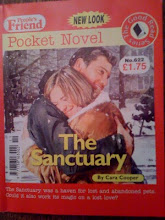Wednesday, 24 April 2013
Writing a Magazine Serial Part 3
I guess there as many different types of serial as there are types of story. For me though, the opportunity to imagine living in a part of the world I love for the months it takes to write a serial was a considerable attraction. I have a sort of holiday disease which I catch every time I go on holiday which consists of imagining vividly what it would be like to chuck in my life in chilly old England (much as I love it here) and go and live abroad.
In the cold light of day, I know that wherever you live there are problems, bills to be paid, cleaning to be done, whatever. But in my imagination, that magic place 'abroad' is always sunny, always exciting and full of possibilities. I think that is why Italy as a setting appealed so much, and if it appeals to me, it was likely it would appeal to readers. People's Friend now have a lovely blog of their own and recently, one of the editors there was talking about how curious it is to work on a magazine where you are always some weeks if not months in advance. So in the sunny, warm days of autumn, they might be choosing articles and reading stories about snow and Christmas. Whilst in the endless winter we have just had I hope it has been as much fun for them as it has been for me to work on something set in the bright, light warmth of an Italian spring.
Setting a serial which is around 45,000 words in somewhere far away, gave me as a writer endless opportunities to indulge myself. Above all it gives you a chance to appeal to the senses of your readers. You can take them for country walks on the cliffs where the smell of wild oregano being crushed beneath footsteps is invigorating. You can take them to a seaside destination where people mess about in boats with all the dramatic possibilities that affords for cliffhangers - characters can fall overboard or get lost in isolated rocky coves. There is endless opportunity for romance in a holiday setting - it is inspirational even when deciding what your characters will wear. I had the English girls in my story befriending a lady who runs a dress shop in Sorrento. They pondered over pretty flip flops with jewels and flowers on the thongs and linen outfits just like you do on holiday. I had fun dressing my characters in flowery, lacy, ice cream shades to my heart's content. Then of course there is the food. Oh the opportunities to enjoy all the things which for me are happy memories of Italian holidays gone by. I had my characters making pasta and zabaglione, tasting liquers and Baci chocolates with yummy toasted hazlenut centres. Then there were the granitas and sorbets and the coffee..... Heaven!
The thing about setting for a magazine serial is of course that it can be anywhere. If I went on my holidays to Norway to see the Northern Lights, to an edgy built up city, to Egypt to see the pyramids, or on a cruise ship to see a whole continent that simply doesn't matter. As long as I was writing about people the reader cares about in situations they which are intriguing I would hopefully stand a chance of being able to run with my idea and seeing it go into print.
Wednesday, 17 April 2013
Writing a magazine serial Part 2
Characterisation - characters are important in most stories but they are particularly key in serials. This is because these are magazine stories particularly aimed at women. Now, women like a cracking good plot as much as anyone. But women on the whole have a higher emotional IQ than men. True, they can enjoy car chases, action scenes, a stirring war tale but very often for a story to last with them, they want to know how people feel and what motivates them. Romance is a big seller and that's no coincidence - it's because people read romances in order to feel something. Now I know this is a huge generalisation and I don't want to annoy any feminists - I guess I'm one myself - I make my own decisions and have always made my own way in life. But I have often put down a book and not turned the next page, or lost interest in a film mainly because I feel nothing for the characters. In women's magazine serials the way to keep someone coming back week after week to buy the next episode is if they care about the players. They have to sympathise with them, or perhaps feel these are people who would be their friends if they met them in real life. Not to say that all your serial characters need to be likeable. They can be villains, but your villains must be interesting and believable.
One of the best ways to reveal your characters is through dialogue and this is an essential element of most serials. If there is something you can reveal through your characters' conversation, then do it, make sure we literally hear their voice. Think of all the TV series that are popular - the soaps, Morse, Downton Abbey - the characters constantly verbalise their feelings and their observations of others.
In my serial, feelings run high. It is after all, a family tale. Had it been about business though or a quest to find out a mystery feelings would still run high. In fact the only sorts of serial I think where perhaps there does not need to be so much emotion is perhaps a comic serial where the reader is kept engaged by the humour. If you can write humour, good luck to you, it is hugely popular and there is a humourous serial running at present in one of the women's mags about a group of retired amateur sleuths which is part of a series which has obviously been popular.
In my story, I had an irascible patriarch father, Salvatore, who runs a family hotel and who his staff fear. He had to be a rounded character though, his children and his wife love him, he is not a baddy, so he had to have redeeming features. After all, he has his Antonio's (our hero) respect. Antonio wants to honour his father and do his duty by helping to run the family business even though his dearest wish is to be an archaeologist. In order for Salvatore to be credible, I had to make him lovable as well as slightly dictatorial. The way I demonstrated this was that he is very much the protector of his children and his wife. Everything he does, he does with the best of motives. He's flawed but he means well. The trouble is, he's old fashioned. So, when his beautiful but wayward teenage daughter Louisa who fancies herself as a bit of a model and a flirt with the local boys gets found out by her father, sparks fly. And there you have another key to characterisation for a serial. There has to be conflict. Have you ever seen an argument in a public place, the street, or a shop? As soon as tensions run high, people stop and look wanting to know what's happening. It's the same in a serial. For through conflict comes suspicion, people behaving badly, worry, anger all those things which make a story interesting. Through the resolution of conflict comes love, redemption, forgiveness, reconciliation - all those things which make the ending of a story satisfying.
Finally, I had a wealth of different characters. They ranged in age from 14 to very elderly, they ranged from wealthy to having problems with money. They ranged from business people to lovely Italian nanas who stayed at home and did lots of cooking (just like my Italian nana did although she ran a successful catering business for many years when she was younger!) I had a fabulous looking Italian detective and a peaches and cream English nanny. The supporting characters, the people working at the hotel, the visiting relatives, a difficult neighbour - were all in their own way as important to the plot as the leading characters. That's not to say their stories overtook the leading characters, your hero and heroine are always the most important and they must remain centre stage if you are writing a romance. If you are writing a police story like a recent shorter magazine serial I read, the detectives must always remain centre stage and not be upstaged by the supporting characters. That said, supporting characters have to be painted large and to have their own individual personalities. That was true in my serial, The Lemon Grove, whether they were a wine drinking blustery Professore or a kind compassionate nana who showed them how to make homemade pasta or whether they were a teenage boy who helps to solve the crime and wants to be a detective when he leaves school. However small a part they played, they had to be written clearly so we knew why they did things and we sympathised with their plight. Then we could feel for them and want to know what happened next.
Good luck with your characters. Next week, I shall be blogging about setting in serials.
Thursday, 11 April 2013
How to write a magazine serial part 1
Hi - I feel awful at not blogging in so long. However my Spring resolution is to improve by doing a series of blogs about how to write a serial for a woman's magazine as that's what's kept me away from the blogosphere.
I can't claim to be an expert but I can claim to have an 8-part serial coming out this summer in The People's Friend. It has been a long, at times painful and at times joyous experience. I know lots of writers wonder about doing serials so thought I'd share what I've learnt in the hope it might be useful.
Getting started..... Very occasionally in life you get lucky like I did when PF asked me to try writing a serial. BUT mostly 'lucky' is a misnomer. By and large I believe you make your own luck. I made mine by being persistent in submitting short stories to women's magazines, I'd been trying for years and finally broke through with PF taking about five of my shorts. Having short stories accepted made me try pocket novels. Once I'd had my sixth one of these published, one of the editors at PF e-mailed and said you can obviously write long as well as short, would you like to try a serial? Would I? You betcha! I wouldn't dream of turning down an offer like that even though it terrified me. I had two possible ideas, one was set in a helicopter rescue squadron in Scotland, the other was a cosy crime/romance set in sunny Italy. I tried the latter on them as I loved the setting and had just been on holiday to Sorrento. I'd done my usual research keeping tickets from ferries and trains, brochures from tourist sites, underground maps etc. I always do this so that I can set a story in a location even if it's years after I've visited. Armed with my research and a hazy plotline about someone who buys a house by the sea in an internet auction I was set to begin. That was my route into serial writing, different writers have different routes to breaking into that genre. One thing's for certain, magazine readers love an absorbing serial and editors are always keen to have good ones because once a reader is hooked they'll come back again and again. One of the main things to remember is what a commitment a serial is. During the two years from start to finish I had numerous other writing commitments on the go from critiquing to writing novellas. Every time I got a serial instalment back though I had to drop those and get cracking on the serial. The editors would gently remind me if there was silence for too long and I knew then, however difficult I was finding it to come up with new plotlines or resolve old plot issues, I needed to come up with the goods. If your writing world is one where because of your day job or other commitments you would find it impossible to keep up the momentum and work to an editor's beck and call you may want to consider whether serial writing is really for you. As editors pay on the submission of each instalment, they are investing pretty highly in your capacity to keep going and come up with the goods right to the last instalment.
What to send..... Firstly, read the magazine's submission guidelines very carefully. If they ask for a two page synopsis and the first instalment, do exactly that, no more, no less. Secondly, read the magazine, get hold of back copies. Study what other serials there have been and try and come up with something different but not so different that it wouldn't be in keeping with what the magazine's values are. Ask friends, neighbours, your FaceBook and Twitter contacts, the lady standing next to you in the supermarket queue, anyone about what magazines they read and why. Hopefully you'll find people who read fiction in mags and they will tell you what grabs them and what doesn't.
Be prepared to do amendments .......... Very lucky is the writer who DOESN'T have to do revisions and remember for a serial you have to have each instalment approved before writing the next. That is one of the frustrations. With a pocket novels I have zoomed along at my own pace and been able to see the novel form in its entirety as one whole piece of work. With a serial be prepared for the stopping and starting. You cannot get into your groove and sail along. You have to hold yourself back and wait sometimes for many weeks (by which time you've forgotten half the story and will have to go back and reread) before you can gear up again. Often, whilst writing one episode I would make notes on the next but I never went further than notes before getting the go ahead as I simply don't have the time to waste. So, in short, accept changes and be open to them. The editors really do know their readers. My first instalment had about nine requests for amendments. I nearly folded up into a little ball and started shaking. They gradually reduced as the instalments went on but then 7&8 both had significant reworkings requested. The main change was, by that time I had become used to them and what looked impossible I knew, with a lot of work, would be sorted.
In my next blogs I'll cover setting, plotting, emotional involvement and characterisation within the serial world.
Subscribe to:
Comments (Atom)













